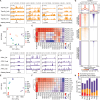Diversifying the anthracycline class of anti-cancer drugs identifies aclarubicin for superior survival of acute myeloid leukemia patients
- PMID: 38831402
- PMCID: PMC11149191
- DOI: 10.1186/s12943-024-02034-7
Diversifying the anthracycline class of anti-cancer drugs identifies aclarubicin for superior survival of acute myeloid leukemia patients
Abstract
The efficacy of anthracycline-based chemotherapeutics, which include doxorubicin and its structural relatives daunorubicin and idarubicin, remains almost unmatched in oncology, despite a side effect profile including cumulative dose-dependent cardiotoxicity, therapy-related malignancies and infertility. Detoxifying anthracyclines while preserving their anti-neoplastic effects is arguably a major unmet need in modern oncology, as cardiovascular complications that limit anti-cancer treatment are a leading cause of morbidity and mortality among the 17 million cancer survivors in the U.S. In this study, we examined different clinically relevant anthracycline drugs for a series of features including mode of action (chromatin and DNA damage), bio-distribution, anti-tumor efficacy and cardiotoxicity in pre-clinical models and patients. The different anthracycline drugs have surprisingly individual efficacy and toxicity profiles. In particular, aclarubicin stands out in pre-clinical models and clinical studies, as it potently kills cancer cells, lacks cardiotoxicity, and can be safely administered even after the maximum cumulative dose of either doxorubicin or idarubicin has been reached. Retrospective analysis of aclarubicin used as second-line treatment for relapsed/refractory AML patients showed survival effects similar to its use in first line, leading to a notable 23% increase in 5-year overall survival compared to other intensive chemotherapies. Considering individual anthracyclines as distinct entities unveils new treatment options, such as the identification of aclarubicin, which significantly improves the survival outcomes of AML patients while mitigating the treatment-limiting side-effects. Building upon these findings, an international multicenter Phase III prospective study is prepared, to integrate aclarubicin into the treatment of relapsed/refractory AML patients.
Keywords: Aclarubicin; Anthracycline; Bio-distribution; Cardiotoxicity; Chromatin damage; Cross-resistance; DNA damage; Doxorubicin; Histone eviction; Refractory/relapsed acute myeloid leukemia.
© 2024. The Author(s).
Conflict of interest statement
J.N. is a shareholder in NIHM that aims to produce Acla for clinical use. The authors do not declare any other competing interests.
Figures





Similar articles
-
Potent immune-dependent anticancer effects of the non-cardiotoxic anthracycline aclarubicin.Oncoimmunology. 2025 Dec;14(1):2515176. doi: 10.1080/2162402X.2025.2515176. Epub 2025 Jun 4. Oncoimmunology. 2025. PMID: 40464096 Free PMC article. Review.
-
Uncoupling DNA damage from chromatin damage to detoxify doxorubicin.Proc Natl Acad Sci U S A. 2020 Jun 30;117(26):15182-15192. doi: 10.1073/pnas.1922072117. Epub 2020 Jun 17. Proc Natl Acad Sci U S A. 2020. PMID: 32554494 Free PMC article.
-
Increasing the dose of aclarubicin in low-dose cytarabine and aclarubicin in combination with granulocyte colony-stimulating factor (CAG regimen) can safely and effectively treat relapsed or refractory acute myeloid leukemia.Int J Hematol. 2014;99(5):603-8. doi: 10.1007/s12185-014-1528-8. Epub 2014 Mar 13. Int J Hematol. 2014. PMID: 24623261
-
Cladribine with Granulocyte Colony-Stimulating Factor, Cytarabine, and Aclarubicin Regimen in Refractory/Relapsed Acute Myeloid Leukemia: A Phase II Multicenter Study.Oncologist. 2020 Nov;25(11):e1663-e1670. doi: 10.1634/theoncologist.2020-0818. Epub 2020 Sep 21. Oncologist. 2020. PMID: 32845551 Free PMC article. Clinical Trial.
-
Phase I and II agents in cancer therapy: I. Anthracyclines and related compounds.J Clin Pharmacol. 1986 Sep-Oct;26(7):491-509. doi: 10.1002/j.1552-4604.1986.tb02942.x. J Clin Pharmacol. 1986. PMID: 2944917 Review.
Cited by
-
Chromatin as an old and new anticancer target.Trends Cancer. 2024 Aug;10(8):696-707. doi: 10.1016/j.trecan.2024.05.005. Epub 2024 Jun 1. Trends Cancer. 2024. PMID: 38825423 Free PMC article. Review.
-
The Application and Molecular Mechanisms of Mitochondria-Targeted Antioxidants in Chemotherapy-Induced Cardiac Injury.Curr Issues Mol Biol. 2025 Mar 7;47(3):176. doi: 10.3390/cimb47030176. Curr Issues Mol Biol. 2025. PMID: 40136430 Free PMC article. Review.
-
Saikosaponin A Mediates the Anti-Acute Myeloid Leukemia Effect via the P-JNK Signaling Pathway Induced by Endoplasmic Reticulum Stress.Drug Des Devel Ther. 2025 Mar 17;19:1983-2001. doi: 10.2147/DDDT.S498458. eCollection 2025. Drug Des Devel Ther. 2025. PMID: 40124558 Free PMC article.
-
Potent immune-dependent anticancer effects of the non-cardiotoxic anthracycline aclarubicin.Oncoimmunology. 2025 Dec;14(1):2515176. doi: 10.1080/2162402X.2025.2515176. Epub 2025 Jun 4. Oncoimmunology. 2025. PMID: 40464096 Free PMC article. Review.
-
Daunorubicin and its hydroxy metabolite in cardiomyocytes: insights into cellular kinetics, toxicity, DNA damage, and dexrazoxane-induced cardioprotection.Arch Toxicol. 2025 Jun 7. doi: 10.1007/s00204-025-04095-z. Online ahead of print. Arch Toxicol. 2025. PMID: 40481868
References
MeSH terms
Substances
Grants and funding
LinkOut - more resources
Full Text Sources
Medical
Molecular Biology Databases
Research Materials

